« July 2005 | Main | September 2005 »
August 31, 2005
Who Built America? The Expanded Textbook
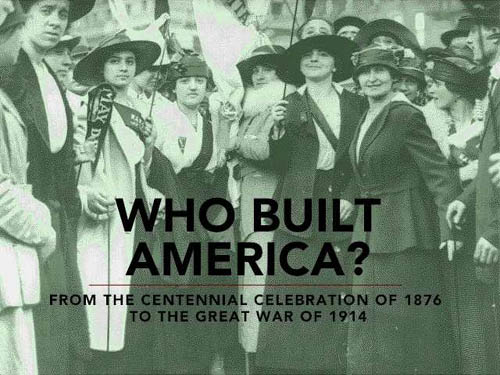
The early and mid-1990s saw a brief but brilliant flowering of CD-ROM publishing that, to some degree, has never been surpassed, even as the world wide web has evolved from a simple hypertext system into a vibrant, interactive medium. In spite of unprecedented accessibility to knowledge resources, and a sprawling social dimension, the web has so far produced very little in the way of educational resources that could legitimately be said to challenge the hegemony of the printed textbook.
For this reason, it is worth looking back at the CD-ROM heyday, when an exciting array of "expanded books" and other genre-busting, interactive works were produced that made prodigious use of multimedia and tested the possibilities of the personal computer as a reading and learning device. At that time, a number of quality educational titles emerged on CD-ROM that suggested a new direction for the textbook. Who Built America?, a publication of the American Social History Project at the City University of New York, is undoubtedly one of the finest.
Based on a comprehensive, two-volume print history, the Who Built America? (WBA) CD-ROMs constitute both a revision and an expansion of the original titles. The first disc covers a period beginning with Reconstruction and running up to the beginning of World War I, while the second picks up at the outbreak of the first great war and follows to the conclusion of the second. Disc 1 (view demo) was released in 1993 by the Voyager Company to great acclaim. But it was not until 2000 that the second disc was published, this time by Worth, in a slightly altered format. Most important, the second disc was built in TK3, a commercially available ebook authoring program developed by Night Kitchen, an outgrowth of the Voyager company, and progenitor of The Institute for the Future of the Book.
The choice of TK3 highlights another key challenge for redefining the textbook in the digital age: an electronic textbook cannot be read-only. It must allow the reader to personalize the text, making annotations, highlighting passages, inserting memory aids. TK3 enables this, preserving many of the most crucial affordances of print books with tools such as highlighting, sticky notes, notepads, and even a way to dog-ear pages.
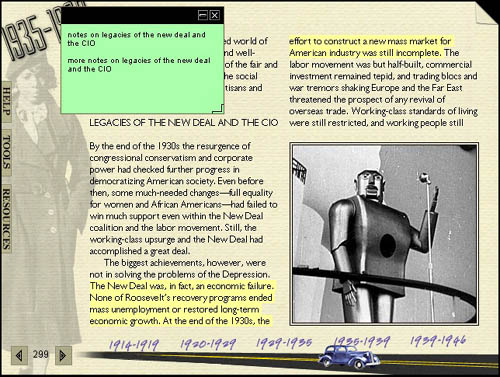
These familiar features are then augmented by the unique affordances of digital machines: rich multimedia, connectivity to the global network, and powerful search capability. This is the textbook enhanced. (more about TK3)
Retaining the basic printed textbook format, each WBA disc contains approximately 3,000 source documents - text, audio, film and links to the world wide web. In effect, the textbook expands into a nearly bottomless resource, while preserving the rigor of a bounded print text.
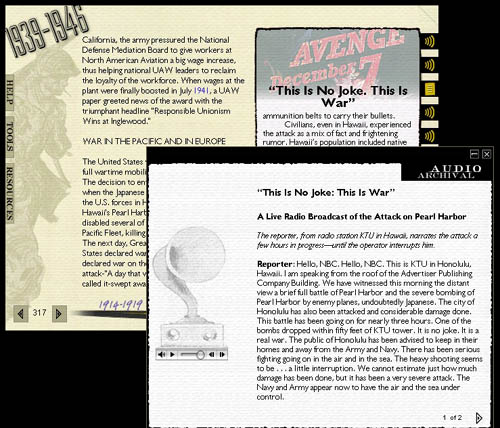
Even more significant, by placing source materials alongside the authors' exposition, a student is better able to make sense of the book as a work of scholarship, and even to challenge the authors' assumptions by drawing their own conclusions based on unvarnished, documentary evidence. The implications of this are profound, since the textbook has long been a top-down instrument of unquestionable authority.
Posted by ben vershbow at 12:17 PM
August 29, 2005
ICONS: Simulating the Game of Global Politics Online
![]()
ICONS is a program developed by the University of Maryland that weds the study of global politics - for high school, university, and professional-level students - with live, simulated negotiation. Anyone who did Model U.N. in high school will find this familiar. Only with ICONS, the simulation space is online and conferences take place across the network.
Each academic year ICONS organizes distributed and single-classroom simulations for paying participants. Scenarios are timely and relevant to real-world political developments, ranging from international health crises, to environmental or financial treaties, to security and anti-terrorism issues. The idea is for an ICONS simulation to be inserted into a lesson plan or curriculum as a purpose-driven, high stakes component. A simulation is a tool that applies and activates the usual course of study by placing students into a live, contentious situation where they must solve a real-world problem and juggle a host of competing interests.
![]()
Proposal: Peace Plan for Algeria
Simulations actually take place on the ICONSnet - a secure online playspace providing communications infrastructure and workspace for conference participants. ICONSnet is entirely web-based, requiring no client software on individual students' machines. When logged on, students can send messages to fellow team members or to other teams. They can draft and vote on proposals, amend existing ones, and engage in real-time conferences with other groups. All the while, instructors can evaluate students through private progress reports from the teams and by monitoring message and conference logs.
![]()
Proposal List
A typical simulation involves 15-20 teams, each representing a different country. The process can be broken up into three main stages (taken from the ICONS site):
Pre-simulation Preparation (4-6 weeks):Students work as a team to research positions using the ICONS research library and other online resources to determine a negotiating strategy for their role in the simulation.
Simulation Participation - Negotiation & Decision-Making (4-5 weeks):Students pursue their specific goals through interactions with other teams using the ICONSnet online communication system. This may include messaging, conferences and consideration of proposals.
Post-Simulation Debriefing (~2 weeks):Teachers lead students through written and verbal reviews of the exercise to reinforce learning objectives.
Teachers and developers can also design their own simulation using the Simulation Builder, but they still must pay for access to the ICONSnet. The site also features a Research Library stocked with useful resources that students can use to prepare for ICONS simulations: country and regional profiles; links to government sites, charters and treaties; link bibliographies for various issue areas; and a rich aggregation of news sources.
Strong as it is, however, the library would benefit from a thorough revision, and should probably be more customizable by users. For example, most of the news sources appear to have been last updated in 2003, but by now, most of them probably have RSS feeds. The page could easily be restructured to incorporate a feed reader that would allow individual students to organize syndicated content by region, issue area and other criteria.
Posted by ben vershbow at 9:43 PM
The Colombia Project: A Portable Mini-Language Lab
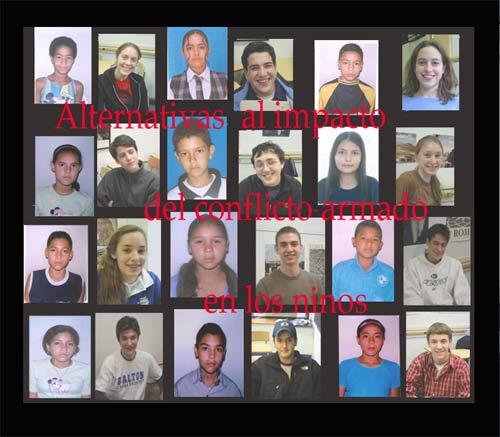
![]()

Until recently, the use of technology in language labs didn't go much further than pre-recorded audio to introduce the vernacular of native speakers, or a videotape to contextualize cultural issues. These canned, artificial products often presented generalized or stereotyped notions of life in foreign countries and rarely addressed harsh realities such as war, poverty, and internal displacement. Student interaction with these objects was equally artificial and seldom involved critical thinking or personal introspection.
Sol Gaitan, a high school teacher at the Dalton School in Manhattan, has found a way to use multiple media to create a learning environment for the foreign language classroom that goes well beyond the traditional language lab. Her mini-lab exists within a composite assignment for her Advanced Spanish IV class. According to Ms. Gaitan, "the project targets the multiple language skills involved in the process of learning a foreign language." The project, built in TK3, employs images, sound, live links, and annotated text to increase student investment and add depth and complexity to the language lab experience.
The framework for the project asks Dalton students to consider the impact of war on children in Colombia. An opening slideshow includes photographs that highlight the harsh reality of guerilla warfare in order to introduce Dalton students to the daily conditions faced by children living in these areas.
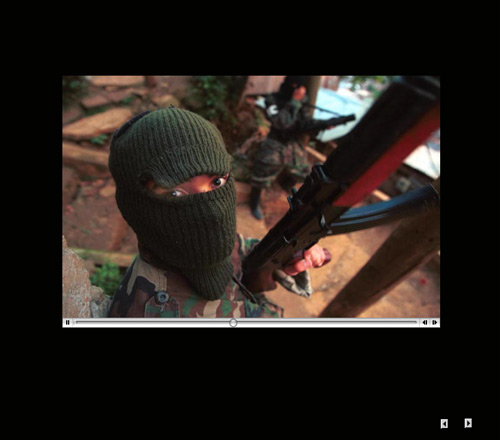
To prepare this project, Ms. Gaitan visited a school in Medellin, Colombia's second largest city. This particular school is located on the outskirts of Medellin, and is populated by people who have been displaced by war.
Ms. Gaitan asked the Colombian students to write essays about their lives. She took these handwritten documents back to New York to share with her students. The mini-biographies were scanned and incorporated into separate digital books. Each Dalton student received an essay written by a different Colombian student. They began the lab assignment by reading these short biographies, deciphering the handwritten text, and re-writing the essays in Spanish, correcting grammar and orthography.
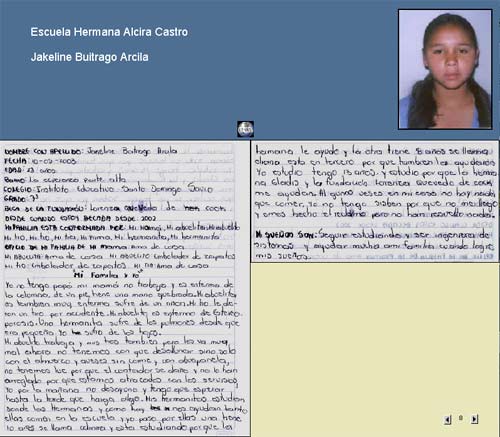
Once the essays were properly transcribed, students were assigned the task of translating them into English. Spanish and English versions were presented in parallel columns in the TK3 book, with a scrolling image of the primary source at the top of the page.

Students were then asked to think deeply about the material and to write an analytical essay addressing the impact of war and displacement on adolescents whose circumstances are different from their own. These essays were written in Spanish and added to the TK3 books. Students also produced short, improvised oral reactions to what they learned in the assignment. These oral exercises were recorded and included in their TK3 books. This year, Ms. Gaitan asked the students to produce dialogs instead of monologs. She found that dialogs, "gave the oral part a much more 'real' and impromptu character." She further improved the project by renaming it to emphasize the personal nature of the exploration:
The second time around, I called the project 'Reflexion/Reflejo. Vidas paralelas' and asked the students to see their Colombian counterparts as a mirror upon which they saw themselves, as a reflection (reflejo,) and then to write down their reflections (reflexion.) Their writing is much more personal than those of the previous year. The final pieces, complete with the dialogs, are sort of parallel lives (vidas paralelas.) Language, history and culture internalized this way, become intimate.

Instructor Sol Gaitan had this testimony about the success of the project.
Reading original manuscripts has exposed them to vernacular Spanish spoken by children their age in a way that printed text could never achieve. They have also realized how much Spanish they know, and how correct it is. They are thrilled to be authoring a little book on a topic on which they are becoming experts, thanks to the easy and direct access to the Internet provided by links created by me in the introductory material. For me, as language teacher, the icing on the cake is to have their oral commentary documented. This will allow me to assess each student's pronunciation patterns, fluency, and ability to improvise.
Posted by kim white at 11:43 AM
August 1, 2005
Ivanhoe: An Online Playspace For Collaborative Interpretation
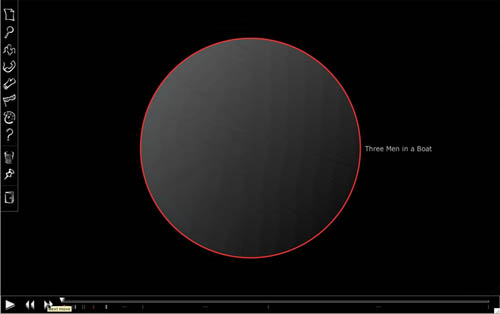
Back in 2000, University of Virginia English professors Jerome McGann and Johanna Drucker exchanged a series of emails in which they attempted to re-write the conclusion of Sir Walter Scott's epic romance, Ivanhoe. They did this to answer a question:
"How might the rewriting of a literary text provide self-conscious insight into the literary work and into the processes of interpretation constituted by any and every act of reading?"
The question stemmed from a larger preoccupation that they shared, namely that digital machines and the web are changing the way we read and process texts. The game of re-writing seemed somehow to fit with this. They wondered how this playful, interpretative experiment might be expanded and systematized for an online space - one that would allow multiple readers to interpret a text collaboratively, even competitively? Theories developed, diagrams were sketched, and before long, the foundations were laid for an exciting new approach to textual studies.
The Ivanhoe exercise led to a series of classroom experiments - interpretive games played around a variety of literary texts from Wuthering Heights to A Wrinkle In Time. The games were essentially collaborative research projects, and made use of the limited tools on hand, chiefly blogs. But the theoretical discussions that coincided were all focused on building some kind of specialized tool, a virtual game board. This was taken up by UVA's Applied Research in Patacriticism initiative in collaboration with the Speculative Computing Lab (SpecLab), bringing together textual studies, visual theory and serious programming power.
In its present form, Ivanhoe is an online playspace for multi-player collaboritive interpretation. Each player chooses a role, which is at the very least a kind of moniker, and at most an entirely new persona through which they will engage the text and other participants. A game is made up of "moves." A move might be a gloss, a comment, a re-write of a text, the presentation of a new document, an entry in a journal etc. Each player must provide justification before "publishing" a move, and once the move is published it is permanently logged in the game.
Like any great classroom discussion, a game can veer into tangential territory, new evidence can come to light, and playful inventions can arise. In the playspace, each of these developments, large and small, assumes a visual presence on the subjective landscape. It is a landscape that is constantly shifting, in part because it depicts a living process, but also because the point of view is always moving from player to player. This, too, is depicted visually. When one point of view is selected, its relationship to other players and to various moves and documents is highlighted.
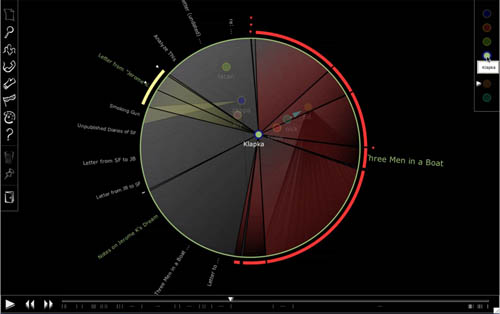
As stated in the online demo: a "role's position in the discourse field is the product of their relation to other players and actions taken." When games become sufficiently complex, with multiple players entwined in multiple subjective trajectories, they begin to resemble Suprematist paintings, with circles, triangles and vectors cutting across the central sphere.
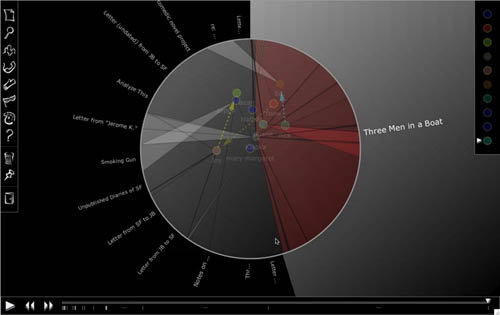
Ivanhoe is intended to investigate how human interaction with machines might illuminate and call attention to the interpretative processes of the individual reader. By situating these processes in a game space governed by certain rules and procedures, awareness is cultivated in the players of individual interpretive acts and of their place in a progression, or digression. It also asks how digital instruments and social software might facilitate collaboration - or even a more productive kind of competition - in the humanities. To quote from "Reflections on the Ivanhoe Game" in TEXT Technology (Drucker and Rockwell 1983) (download pdf), an article chronicling the project's history:
"Collaborative work is still novel in the Humanities, but will increase. Shared resources aggregated from geographically distributed collections create altered conditions for editing and study. Our aim is to concentrate the development of these features in a concerted effort towards increasing awareness of interpretation as a process. One might argue, in fact, that interpretation in its subjective and historical dimensions is the core activity of humanities."
Posted by ben vershbow at 10:51 PM
